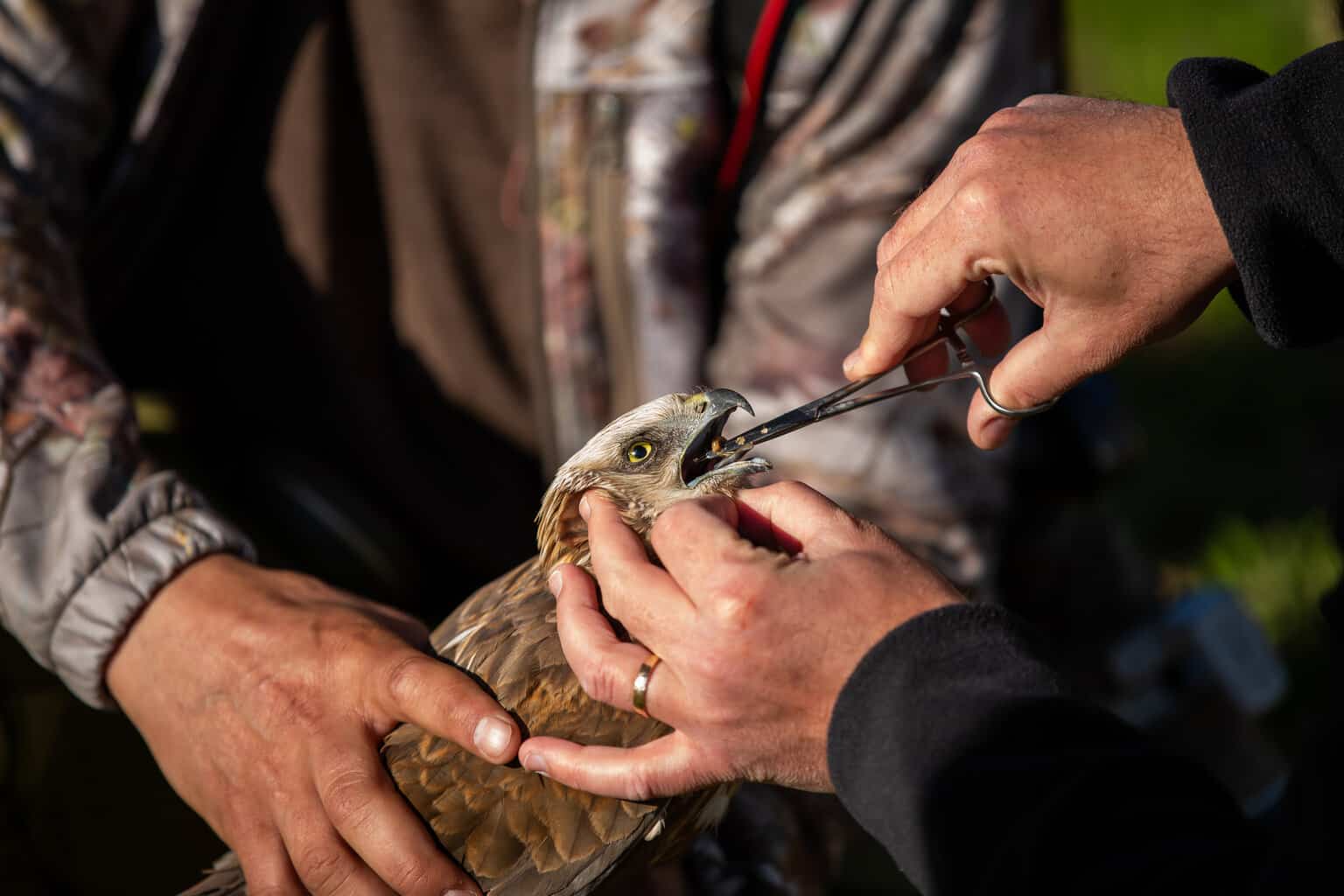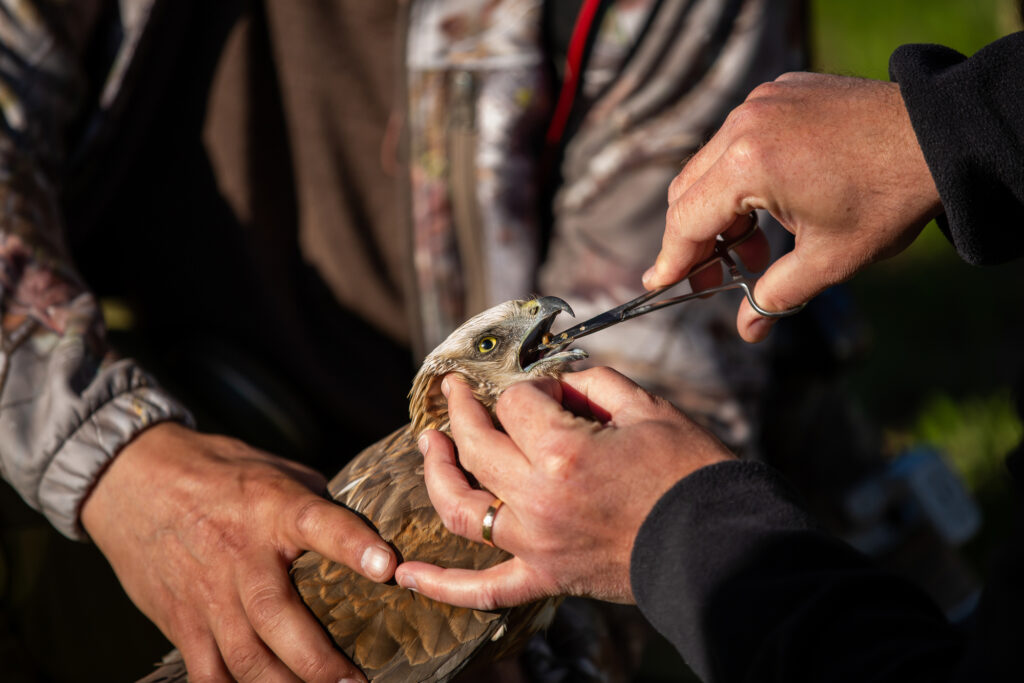It’s in the nature of compassionate people to help a bird that’s been (or appears to be) injured – especially if that injury happened on our property. However, if you’re worried about an injured bird, it’s best to do less rather than more.
If we saw the injury occur, we may wish to rush straight to the bird’s aid. In reality, a wait-and-watch approach is best.
Sometimes, a bird’s able to recover on its own and will do best if we leave it to its own devices and let it recover, rather than adding to its stress by getting too close. The stress of human interaction might be just as bad for the bird as the stress of the initial injury.
Though you can help a bird, and take steps to reduce its stress, you should always call in a licensed expert for any medical treatment required and for rehabilitation.
What approach we should take depends on specific circumstances. For instance, it’ll depend on whether we saw what happened or can immediately see the cause of any issue.
We at WildBirdScoop know how important bird safety and conservation are for the environment. However, this guide will ensure you don’t accidentally do more harm than good.
Key Takeaways
- While our instincts may urge us to rush up and help an injured bird, a cautious wait-and-see approach is vital. The bird might just recover on its own.
- Direct human intervention should be limited to placing the bird in a safe, quiet environment. For medical treatment, you should always contact a licensed wildlife rehabilitator.
- Identifying an injured bird means looking for signs like a lack of movement, unsuccessful flight attempts, and visible wounds. However, any hands-on care should be left to professionals to avoid health complications or legal issues.
How Are Birds Injured?
There are many ways wild birds can be injured in or around homes and gardens – areas of human habitation.
Birds frequently fly into windows or other reflective surfaces. They can become trapped in netting or wire.
They can fall down chimneys. They can be hit by cars or other vehicles.
Of course, another major cause of bird injury is predation, such as attacks by cats and dogs. Sadly, you may sometimes have to retrieve a bird that has been caught or toyed with by a pet. You may wonder what to do with the poor bird that you just rescued.
Sometimes, an injured bird may end up in your garden with no clear signs as to what occurred. A bird may have suffered some unknown mishap or been attacked by a natural predator close by.
How To Tell if a Bird Is Injured
Signs to look out for when trying to determine whether a bird is injured or in need include:
- A lack of movement (and especially failure to fly away when approached), even after you’ve monitored the situation for a while to see whether the bird was simply in shock.
- Attempts at flying that are not successful, suggesting weak flight muscles, a broken wing, or other anatomical issues.
- Fluffed up or ruffled wing feathers – or generally disordered plumage.
- Issues around the eyes, such as swelling or closed eyes.
- Visible blood or wounds.
- An obviously broken wing, drooping or hanging wing, or dangling leg.
If there’s a lack of movement, but no other visible sign of injury, make sure that you leave the bird for a while and monitor the situation. Even birds that have crashed hard into a window may often fly off after a short time.
Note that you should always be cautious and practice good hygiene when dealing with a bird that is not in good shape. You may inadvertently spread avian diseases.
Should You Help an Injured Bird?
It is important to note that keeping wild birds captive (even for the best of reasons) is sometimes illegal unless you have a license. In some areas, it may be illegal to release a wild bird once you’ve brought it into your home.
Many people ask how to help an adult bird with an injured wing, an injured leg, or a bird who’s been injured by a window or a cat.
The answer is always the same – don’t attempt treatment on your own, simply keep the bird as comfortable as you can in the short term, and call for help.
Below is a short and helpful video showcasing a few of the essentials covered in this list:
Don’t attempt any medical aid on your own, such as attempting to force water or food on the injured bird. This may do more harm than good — years of training are required to understand animal medical care and wildlife rehabilitation.
The bird may need specific medical attention that a layperson cannot provide. Depending on the species and age, they may require an extremely specific feeding regime and other care.
What To Do if You Find an Injured Bird
If you’ve watched and waited, or if the bird is in danger of further injury or death, then you can very carefully place the bird into a well-ventilated cardboard box with a lid or towel over the top.
If you don’t have a box handy, a cloth tote bag will be fine – perhaps secured with binder clips.
Carefully place the box or bag in a cool, quiet, safe place. Darkness and a calm, quiet environment will reduce the bird’s stress. Sadly, birds can easily succumb to shock and die from it.
After around 15 minutes, take the box outside and see whether or not the bird is capable of flying away. Repeat this process a few times.
If the bird doesn’t recover and is unable to fly, you should call a licensed wildlife rehabilitator or wildlife rescue center in your area. They’ll advise you on the next step and may come out to recover the injured bird or direct you on where to take it.
How Long Does It Take an Injured Bird To Recover?
There is no one answer to this question. Birds that are simply stunned or in shock, such as window collision victims, may recover to the point where they can fly off in just a few moments.
But for other injured birds, recovery may take much, much longer.
This is why helping an injured bird longer term is best left to the experts. There are too many unknowns for those who aren’t experts in bird anatomy and bird health.
What To Do If You Find an Injured Baby Bird

If you find a baby bird on its own, you may be tempted to rush in right away and save the poor creature. Before you do anything, it is very important to wait, watch and observe.
Wherever possible, it’s best to call in experts rather than attempting a rescue yourself, since there is a lot of complexity and effort involved. How, when, and what you can feed baby birds depends on a range of factors including their specific species and stage of growth.
Therefore, if you think a baby bird may need help, call a local wildlife charity or licensed animal rescue center. They’ll know precisely how to give the baby bird the best possible chance of survival.
The first thing to determine is whether the baby bird you are looking at is a nestling or a fledgling. Nestlings are tiny baby birds that should not usually leave the nest.
They can sometimes fall out and end up on the ground. A nestling will often be bare or have few feathers.
Fledglings are baby birds that have grown to the stage where they are ready to fly the nest. Because these young birds are just learning to fly, they may often spend quite a lot of time on the ground and linger around where their parents still help them out.
Fledglings will usually have many feathers in place, though won’t have full adult plumage.
Note that both nestlings and fledglings may not be injured after their fall – though they might find themselves in very vulnerable positions.
What To Do if You Find a Nestling That Has Fallen From a Nest
If you see a nestling and can see a nest nearby, the first course of action should be to see if you can gently return the baby bird to the nest.
It used to be thought that parent birds would stop caring for a baby bird if it had a human scent. It’s now believed most parents will continue to feed a baby if they can, whether it has been touched by a human or not.
If the nest has fallen onto the ground, try to place it back up in a tree or shrub, where it will be safer from predators. Place the baby bird very carefully back into it.
Watch the nest from a distance for the next couple of hours. Hopefully, the parent or parents will return.
If there is no sign of a parent, or there is no nest in sight, you might need to take further action and hand-rearing may be required (best left to experts).
What To Do if You Find a Fledgling Bird
If you see a fledgling bird, first observe the situation to see whether the bird is in trouble. If the bird is uninjured, you may simply watch and wait to see if parents show up to feed it or if it flies off by itself.
If you’re certain the bird isn’t just resting, and there seem to be no adults nearby, you might consider placing some shelter like a branch with leaves over it to reduce the chance of predation. The fledgling may still recover and fly off.
If the fledgling doesn’t recover, it’s a good idea to call in the experts. If the bird is in a vulnerable position, you might place the bird in a well-ventilated box until help arrives.
You should not attempt to rear the fledgling on your own as this takes specialist knowledge.
Remember, when dealing with any injured bird, minimal intervention is best. Improper care can do more harm than good.

